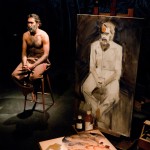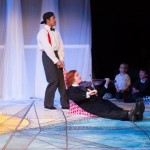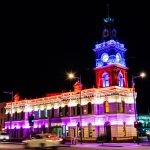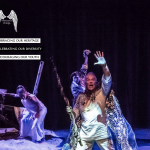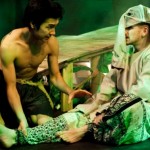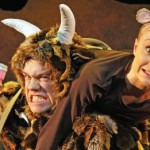Autumn Fires
Genre: Drama
Venue: Finborough Theatre 118 Finborough Road London SW10 9ED
Low Down
The revolutionary nature of Dublin’s Abbey Theatre is well documented through plays by Sean O’Casey and his tackling of Irish Nationalism. Perhaps less remembered is the nuanced ways in which social realism enabled Irish playwrights to critically view the social conservatism of Irish society under the influence of women as ‘God’s police’. T. C. Murray’s Autumn Fire explores sexual desire around a ‘May – December’ coupling of young Nance to a virile older man, Owen Keegan. Questions of masculine physical prowess are set alongside those of the ‘natural order of things’, as the couple move through their secret courtship and marry at the expense of keeping in motion family hostilities. Director Veronica Quilligan shapes the truth of human desires in delicate ways as she gives the story a space to be reimagined beyond Ireland in the1920s.
Review
Nonetheless, the attraction of Autumn Fire is very much tied up with experiencing the melodious sounds of it Irish brogue. It is language, rather than physical touch, which is the key factor that seems to bind and repel characters in the play. The opening scene, for instance, is a confronting dialogue between Nance and Ellen, who, as future wife and daughter of Owen Keegan, are the two women who fuel key dramatic turning points of the drama. Ellen Keegan, strongly portrayed by Aoife McMahon, possesses a shrewish tongue and a desperate need to rule over her father’s house as if it was her own. She knows that her marital prospects have vanished. Why she has this view of herself isn’t revealed until much later in the play: a fact that Murray seems to deliberately arrange to maximise Ellen’s shrewishness.
So, the audience is immediately confronted in the opening scene by Nance and Ellen’s antagonism. The beautiful Nance and the plain looking Ellen are further characterised through contrasting styles of dress: Ellen in her shapeless house frock and faded apron and Nance, an accomplished dressmaker, in her little autumnal-burnt-orange dress that shows off her lovely legs and arms. However, it is demanding language of the play which resurfaces many times as actors stumbled over their lines: an occurrence which is likely to change as the season develops.
The production’s set, lighting and costume designers create the rural ambience of village life, a life in which everyone’s behaviour is scrutinised. The set design by Phillip Lindley consists of a raised platform upstage, on which the kitchen table is placed, separated from the auditorium by a large thrust stage. This thrust doubles as both an indoor and outdoor setting – the Keegan’s front yard, the front porch and Nance’s sewing room. It is a platform on which promises of love are negotiated and fought about: above all, it is the arena in which Owen Keegan’s passions are expressed before they are cooled by theinfirmities of age.
Sophia Anastasiou’s costume designs are a central motif of the drama. They range from elegant country squire attire, worn by the Keegan men – Owen, his son Michael and brother Morgan – to the darker and more sombre dresses of Ellen Keegan and Nance’s mother and the colourful dresses worn by the flirty Molly Hurley and the beautiful Nance Desmond. Even as ‘Mrs Keegan’ Nance dress embodies the rich tones of the earth in which the harvesters’ reap the autumn harvest. All the design elements are integrated well and evoke the characters’ desperate attempting to suppress their sexual desires and romantic sensibilities.
This is particularly true of central character, Owen Keegan, whose desire for the much younger Nance, who is the same age as his children, cannot be sustained. Luke Hayden’s portrayal is convincing as the larger-than-life local hurling hero. His accomplishments enchant Nance from the moment she sets eyes on him on her return from ‘the town’ to the village to care for her mother. The drama then shows how the natural development of the attraction that grows between Nance and Owen’s son, Michael, cannot be consummated. The only comfort to be is found comes through the cold comfort of righteousness. The truth of lost love and impossibility of a meaningful emotional union is poignantly enacted in the closing moments of the play as Ellen’s moral victory over Nance is set against her father’s brokenness.
I very much enjoyed Autumn Fires and its fine ensemble of actors. If I have any reservations it comes from the fact that I was never totally convinced by the lack of Nance’s and Owen’s physical displays of passion. I found myself asking why doesn’t there exist a more overt display of affection between them, one that is aligned with the portrayal of a hearty Owen who arrives on stage perfectly capable of holding a woman in his arms and pressing up close to her. Similarly, I asked myself why Murray would write into Ellen’s part frequent references to Nance’s ability to manipulate through her looks and feminine wiles yet I saw no hint of her sexual powers to draw Owen towards her? Aside from these questions, it is always interesting for this theatre historian to view the forgotten work of a good playwright.
Reviewed by Josey De Rossi 5 March 2012
Website :
http://www.finboroughtheatre.co.uk/productions/2012/autumn-fire.php
